Ti/RuO2-IrO2-SnO2 Anode for Electrochemical Degradation of Pollutants in Pharmaceutical Wastewater: Optimization and Degradation Performances
Abstract
:1. Introduction
2. Materials and Methods
2.1. Reagent and Materials
2.2. Characterization
2.3. Preparation of the Ti/RuO2-IrO2-SnO2 Electrode
2.4. Experimental Device
2.5. Experimental Procedure and Analytical Methods
3. Results and Discussion
3.1. Characterization of the Electrodes
3.2. Performance of Electrocatalytic Reactor
3.2.1. Effect of Electrode Distance
3.2.2. Effect of Current Density
3.2.3. Effect of Air Flow
3.2.4. Effect of Initial pH
3.3. Characterization of the Electrode after Reaction
4. Conclusions
Author Contributions
Funding
Informed Consent Statement
Data Availability Statement
Acknowledgments
Conflicts of Interest
Abbreviations
| DSA | Dimensionally Stable Anodes |
| COD | Chemical Oxygen Demand |
| EC | Energy Consumption |
References
- Lucas, D.; Barcelo, D.; Rodriguezmozaz, S. Removal of pharmaceuticals from wastewater by fungal treatment and reduction of hazard quotients. Sci. Total Environ. 2016, 571, 909–915. [Google Scholar] [CrossRef] [PubMed]
- Zhao, F.; Ju, F.; Huang, K.; Mao, Y.; Zhang, X.X.; Ren, H.; Zhang, T. Comprehensive insights into the key components of bacterial assemblages in pharmaceutical wastewater treatment plants. Sci. Total Environ. 2019, 651, 2148–2215. [Google Scholar] [CrossRef] [PubMed]
- Zhang, J.F.; Chang, V.W.C.; Giannis, A.; Wang, J.Y. Removal of cytostatic drugs from aquatic environment: A review. Sci. Total Environ. 2013, 445, 281–298. [Google Scholar] [CrossRef] [PubMed]
- Wang, X.H.; Lin, A.Y.C. Is the phototransformation of pharmaceuticals a natural purification process that decreases ecological and human health risks? Environ. Pollut. 2014, 186, 203–215. [Google Scholar] [CrossRef] [PubMed]
- Sarkar, S.; Bhattacharjee, C.; Sarkar, S. Studies on the performance of annular photo reactor (APR) for pharmaceutical wastewater treatment. J. Water Process Eng. 2017, 19, 26–34. [Google Scholar] [CrossRef]
- Mirzaei, A.; Chen, Z.; Haghighat, F.; Yerushalmi, L. Removal of pharmaceuticals from water by homo/heterogonous Fenton-type processes—A review. Chemosphere 2017, 174, 665–688. [Google Scholar] [CrossRef]
- Zhan, J.; Li, Z.; Yu, G.; Pan, X.; Wang, J.; Zhu, W.; Han, X.; Wang, Y. Enhanced treatment of pharmaceutical wastewater by combining three-dimensional electrochemical process with ozonation to in situ regenerate granular activated carbon particle electrodes. Sep. Purif. Technol. 2019, 208, 12–18. [Google Scholar] [CrossRef]
- Li, L.; Jiang, L.; Yang, L.; Li, J.; Lu, N.; Qu, J. Optimization of Degradation Kinetics towards O-CP in H3PW12O40/TiO2 Photoelectrocatalytic System. Sustainability 2019, 11, 3551. [Google Scholar] [CrossRef] [Green Version]
- Chinh, V.D.; Broggi, A.; Di Palma, L.; Scarsella, M.; Speranza, G.; Vilardi, G.; Thang, P.N. XPS spectra analysis of Ti2+, Ti3+ ions and dye photodegradation evaluation of titania-silica mixed oxide nanoparticles. J. Electron. Mater. 2018, 47, 2215–2224. [Google Scholar] [CrossRef]
- Meiramkulova, K.; Jakupova, Z.; Orynbekov, D.; Tashenov, E.; Kydyrbekova, A.; Mkilima, T.; Inglezakis, V.J. Evaluation of electrochemical methods for poultry slaughterhouse wastewater treatment. Sustainability 2020, 12, 5110. [Google Scholar] [CrossRef]
- An, H.; Zhu, B.; Li, J.; Zhou, J.; Wang, S.; Zhang, S.; Wu, S.; Huang, W. Synthesis and characterization of thermally stable nanotubular TiO2 and its photocatalytic activity. J. Phys. Chem. C 2008, 112, 18772–18775. [Google Scholar] [CrossRef]
- Sohn, Y.S.; Smith, Y.R.; Misra, M.; Subramanian, V. Electrochemically assisted photocatalytic degradation of methyl orange using anodized titanium dioxide nanotubes. Appl. Catal. B Environ. 2008, 84, 372–378. [Google Scholar] [CrossRef]
- Kai, H.; Ishibashi, Y.; Mori, T.; Ishibashi, H.; Kawaguchi, I.; Ohwaki, H.; Takemasa, T.; Arizono, K. Decolorization and Estrogenic Activity of Colored Livestock Wastewater after Electrolysis Treatment. J. Mater. Cycles Waste Manag. 2010, 12, 128–135. [Google Scholar] [CrossRef]
- Liu, J.; Huang, L.; Li, S.; Feng, Y. Deep treatment efficiency of electrochemical catalytic oxidation for secondary effluent pharmaceutic. Chin. J. Environ. Eng. 2016, 10, 6269–6274. [Google Scholar]
- Fang, C.; Megharaj, M.; Naidu, R. Electrochemical advanced oxidation processes (EAOP) to degrade per- and polyfluoroalkyl substances (PFASs). J. Adv. Oxid. Technol. 2017, 20. [Google Scholar] [CrossRef]
- Yan, H.; Bai, Z.; Chao, S.; Cui, Q.; Niu, L.; Yang, L.; Qiao, J.; Jiang, K. Effects of additives on palladium nanocrystals supported on multiwalled carbon nanotubes and their electrocatalytic properties toward formic acid oxidation. Ionics 2014, 20, 259–268. [Google Scholar] [CrossRef]
- Guerrini, E.; Colombo, A.; Trasatti, S. Surface modification of RuO2 electrodes by laser irradiation and ion implantation: Evidence of electrocatalytic effects. J. Chem. Sci. 2009, 121, 639. [Google Scholar] [CrossRef]
- Nandi, S.; Nair, A.S.; Pathak, B. First principles investigation on the applicability of ruthenium as a potential ORR catalyst. J. Chem. Sci. 2020, 132, 132. [Google Scholar] [CrossRef]
- Jiang, N.; Wang, Y.; Zhao, Q.; Ye, Z. Application of Ti/IrO2 electrode in the electrochemical oxidation of the TNT red water. Environ. Pollut. 2020, 259, 113801. [Google Scholar] [CrossRef]
- Zhang, Y.; He, P.; Jia, L.; Zhang, T.; Liu, H.; Wang, S.; Zhou, S. Dimensionally stable Ti/SnO2-RuO2 composite electrode based highly efficient electrocatalytic degradation of industrial gallic acid effluent. Chemosphere 2019, 224, 707–715. [Google Scholar] [CrossRef]
- Pathiraja, G.C.; Jayathilaka, P.B.; Weerakkody, C.; Karunarathne, P.; Nanayakkara, N. Comparison study of dimensionally stable anodes for degradation of chlorpyrifos in water. Curr. Sci. 2014, 107, 219–226. [Google Scholar]
- Aguilar, Z.G.; Coreño, O.; Salazar, M.; Sirés, I.; Brillas, E.; Nava, J.L. Ti| Ir–Sn–Sb oxide anode: Service life and role of the acid sites content during water oxidation to hydroxyl radicals. J. Electroanal. Chem. 2018, 820, 82–88. [Google Scholar] [CrossRef]
- Zhang, Y.B.; Ma, Q.Q.; Feng, K.K.; Guo, J.; Wei, X.L.; Shao, Y.Q.; Zhuang, J.H.; Lin, T.S. Effects of microstructure and electrochemical properties of Ti/IrO2–SnO2–Ta2O5 as anodes on binder-free asymmetric supercapacitors with Ti/RuO2–NiO as cathodes. Ceram. Int. 2020, 46, 17640–17650. [Google Scholar] [CrossRef]
- Xin, Y.L.; Xu, L.K.; Wang, J.; Li, X. Effect of sintering temperature on microstructure and electrocatalytic properties of Ti/IrO2-Ta2O5 Anodes by pechini method. Rare Met. Mater. Eng. 2010, 39, 1903–1907. [Google Scholar]
- National Environmental Protection Agency. Water and Waste Water Monitoring and Analysis Method, 4th ed.; China Environmental Press: Beijing, China, 2002. [Google Scholar]
- Sun, W.; Ma, B.; Sun, Y.; Zheng, H.; Ma, G. Electrochemical degradation of tetracycline by γ-Al2O3-Bi-(Sn/Sb) three-dimensional particle electrode. Desalin. Water Treat. 2017, 98, 152–160. [Google Scholar] [CrossRef]
- Mukimin, A.; Vistanty, H.; Zen, N.; Purwanto, A.; Wicaksono, K.A. Performance of bioequalization-electrocatalytic integrated method for pollutants removal of hand-drawn batik wastewater. J. Water Process Eng. 2018, 21, 77–83. [Google Scholar] [CrossRef]
- Wang, H.; Wang, J.; Bo, G.; Wu, S.; Luo, L. Degradation of pollutants in polluted river water using Ti/IrO2-Ta2O5 coating electrode and evaluation of electrode characteristics. J. Clean. Prod. 2020, 273, 123019. [Google Scholar] [CrossRef]
- Lv, G.; Wu, D.; Fu, R. Performance of carbon aerogels particle electrodes for the aqueous phase electro-catalytic oxidation of simulated phenol wastewaters. J. Hazard. Mater. 2009, 165, 961–966. [Google Scholar] [CrossRef]
- Tijani, J.O.; Fatoba, O.O.; Madzivire, G.; Petrik, L.F. A review of combined advanced oxidation technologies for the removal of organic pollutants from water. Water Air Soil Pollut. 2014, 225, 2102. [Google Scholar] [CrossRef] [Green Version]
- Zhang, C.; Jiang, Y.; Li, Y.; Hu, Z.; Zhou, L.; Zhou, M. Three-dimensional electrochemical process for wastewater treatment: A general review. Chem. Eng. J. 2013, 228, 455–467. [Google Scholar] [CrossRef]
- Raschitor, A.; Llanos, J.; Canizares, P.; Rodrigo, M.A. (Novel integrated electrodialysis/electro-oxidation process for the efficient degradation of 2, 4-dichlorophenoxyacetic acid. Chemosphere 2017, 182, 85–89. [Google Scholar] [CrossRef] [PubMed]
- Sun, Y.; Zhu, S.; Sun, W.; Zheng, H. Degradation of high-chemical oxygen demand concentration pesticide wastewater by 3D electrocatalytic oxidation. J. Environ. Chem. Eng. 2019, 7, 103276. [Google Scholar] [CrossRef]
- Ventura, A.; Jacquet, G.; Bermond, A.; Camel, V. Electrochemical generation of the Fenton’s reagent: Application to atrazine degradation. Water Res. 2002, 36, 3517–3522. [Google Scholar] [CrossRef]
- Pangarkar, B.L.; Deshmukh, S.K.; Thorat, P.V. Multi-effect air gap membrane distillation process for pesticide wastewater treatment. Membr. Water Treat. 2017, 8, 529–541. [Google Scholar]
- Weisz, A.D.; Rodenas, L.G.; Morando, P.J.; Regazzoni, A.E.; Blesa, M.A. FTIR study of the adsorption of single pollutants and mixtures of pollutants onto titanium dioxide in water: Oxalic and salicylic acids. Catal. Today 2002, 76, 103–112. [Google Scholar] [CrossRef]
- Bi, Q. Investigation on Preparation and Properties of Electrode Materials for Electrochemical Oxidation of Organic Wastewater. Ph.D. Thesis, Xi’an University of Architecture and Technology, Xi’an, China, 2014. [Google Scholar]
- Wu, X.; Yang, X.; Wu, D.; Fu, R. Feasibility study of using carbon aerogel as particle electrodes for decoloration of RBRX dye solution in a three-dimensional electrode reactor. Chem. Eng. J. 2008, 138, 47–54. [Google Scholar] [CrossRef]
- Xiong, Y.; He, C.; Karlsson, H.T.; Zhu, X. Performance of three-phase three-dimensional electrode reactor for the reduction of COD in simulated wastewater-containing phenol. Chemosphere 2003, 50, 131–136. [Google Scholar] [CrossRef]
- Yan, L.; Ma, H.; Wang, B.; Wang, Y.; Chen, Y. Electrochemical treatment of petroleum refinery wastewater with three-dimensional multi-phase electrode. Desalination 2011, 276, 397–402. [Google Scholar] [CrossRef]
- Horáková, M.; Klementová, Š.; Kříž, P.; Balakrishna, S.K.; Špatenka, P.; Golovko, O.; Hájková, P.; Exnar, P. The synergistic effect of advanced oxidation processes to eliminate resistant chemical compounds. Surf. Coat. Technol. 2014, 241, 154–158. [Google Scholar] [CrossRef]
- Feng, Y.J.; Li, X.Y. Electro-catalytic oxidation of phenol on several metal-oxide electrodes in aqueous solution. Water Res. 2003, 37, 2399–2407. [Google Scholar] [CrossRef]
- García-Mancha, N.; Monsalvo, V.M.; Puyol, D.; Rodriguez, J.J.; Mohedano, A.F. Enhanced anaerobic degradability of highly polluted pesticides-bearing wastewater under thermophilic conditions. J. Hazard. Mater. 2017, 339, 320–329. [Google Scholar] [CrossRef] [PubMed]
- Vuorilehto, K.; Tamminen, A. Application of a solid ion-exchange electrolyte in three-dimensional electrodes. J. Appl. Electrochem. 1997, 27, 749–755. [Google Scholar] [CrossRef]
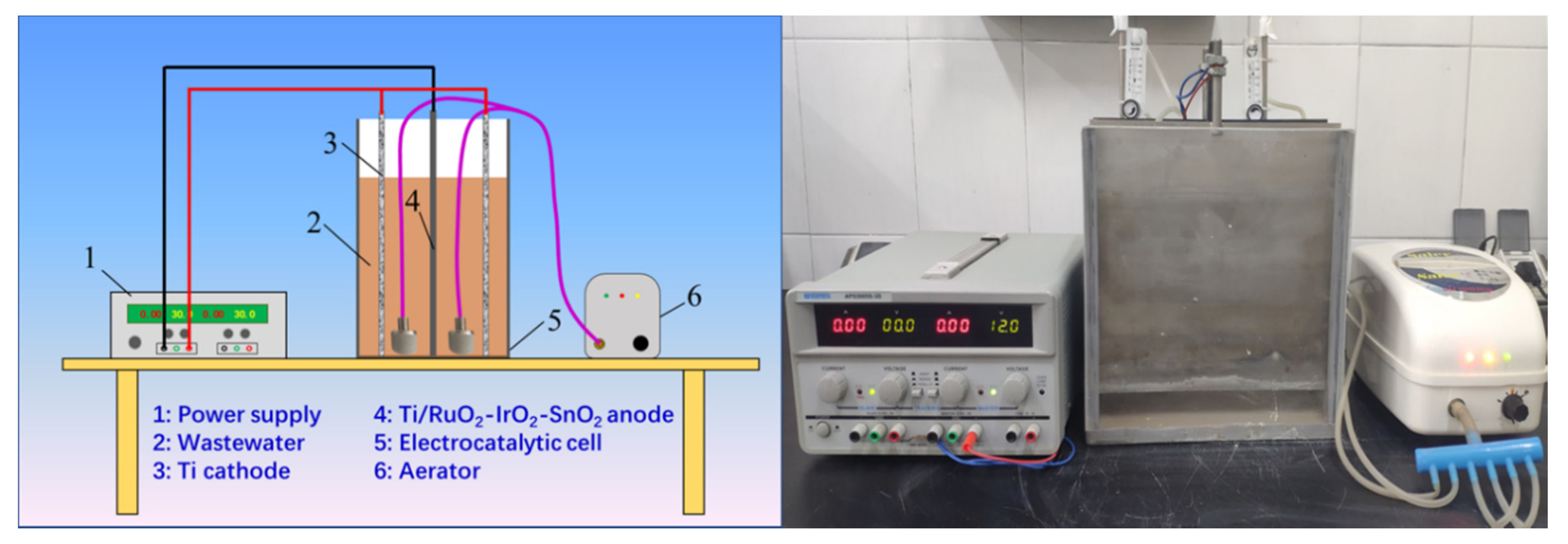
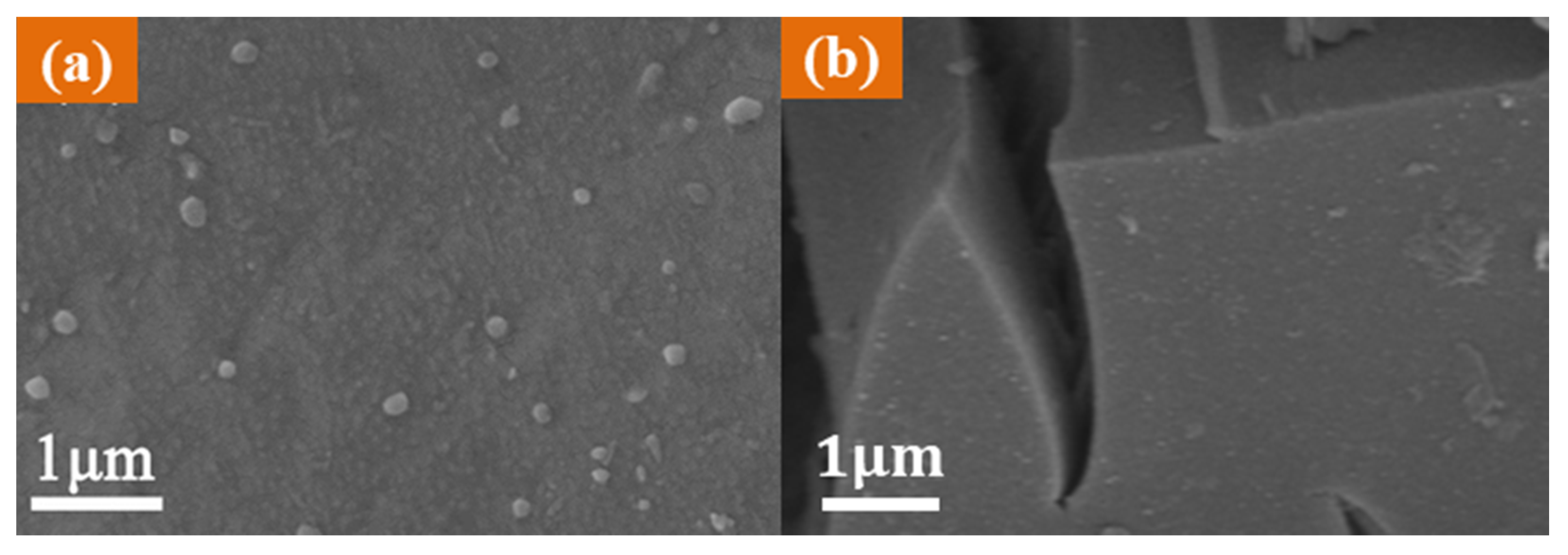
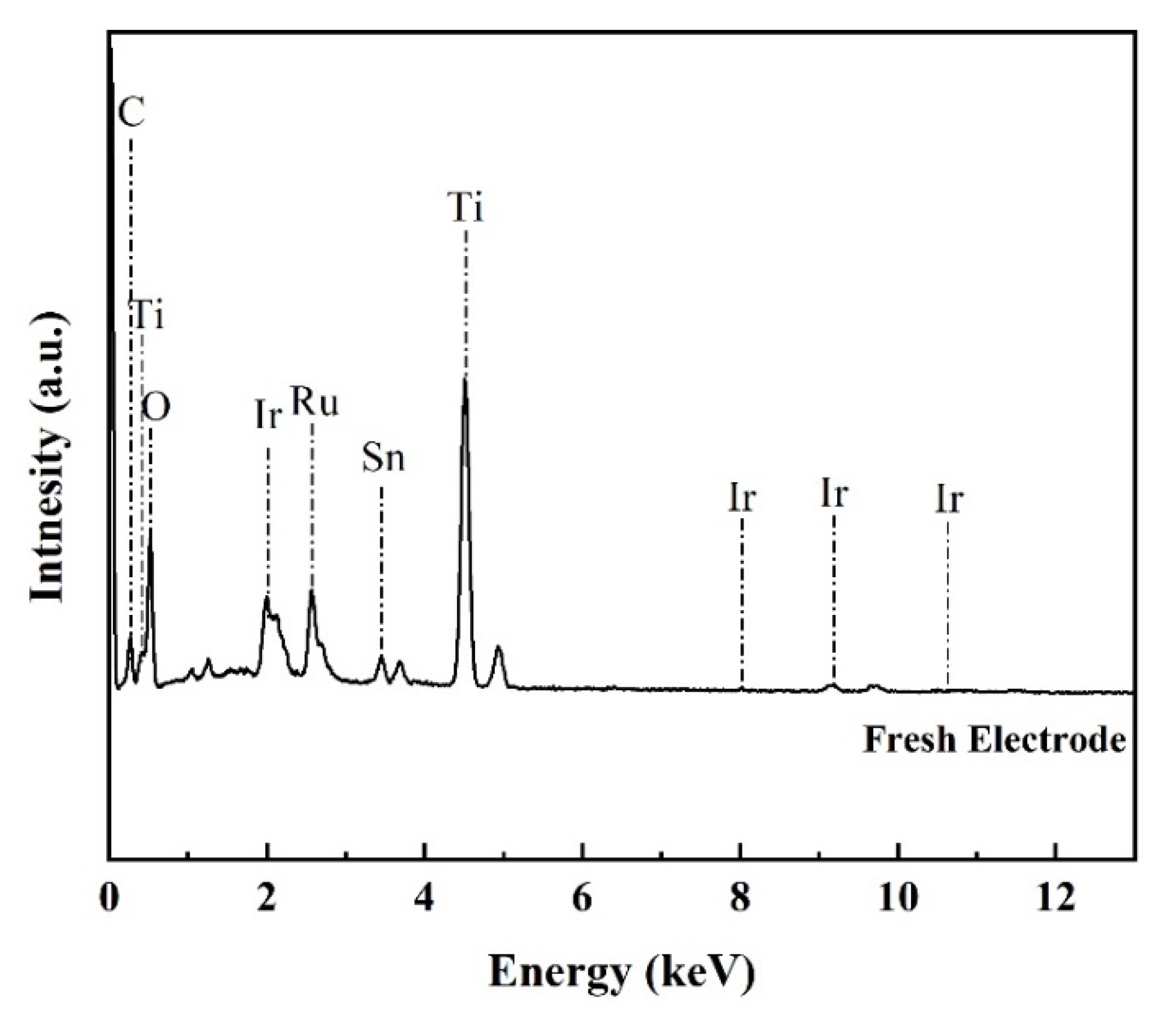
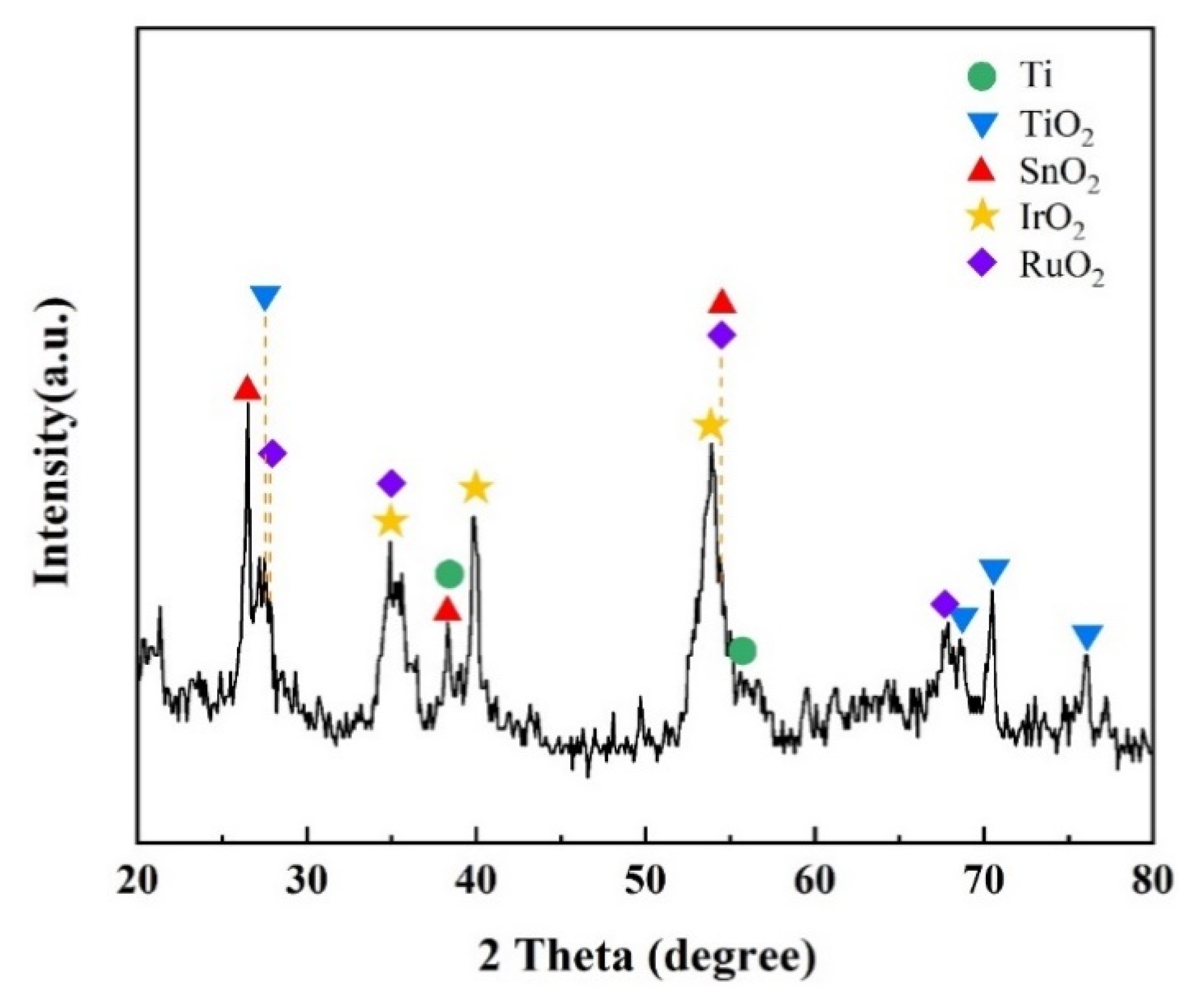

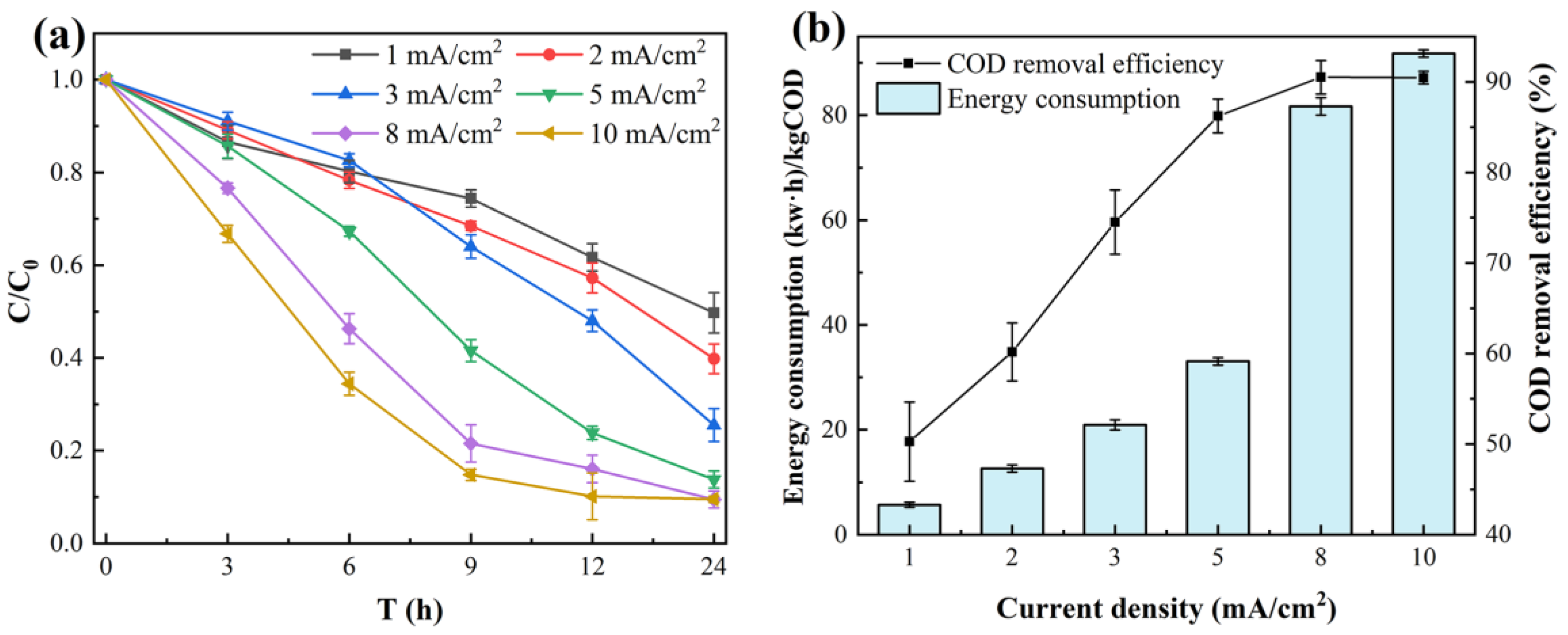
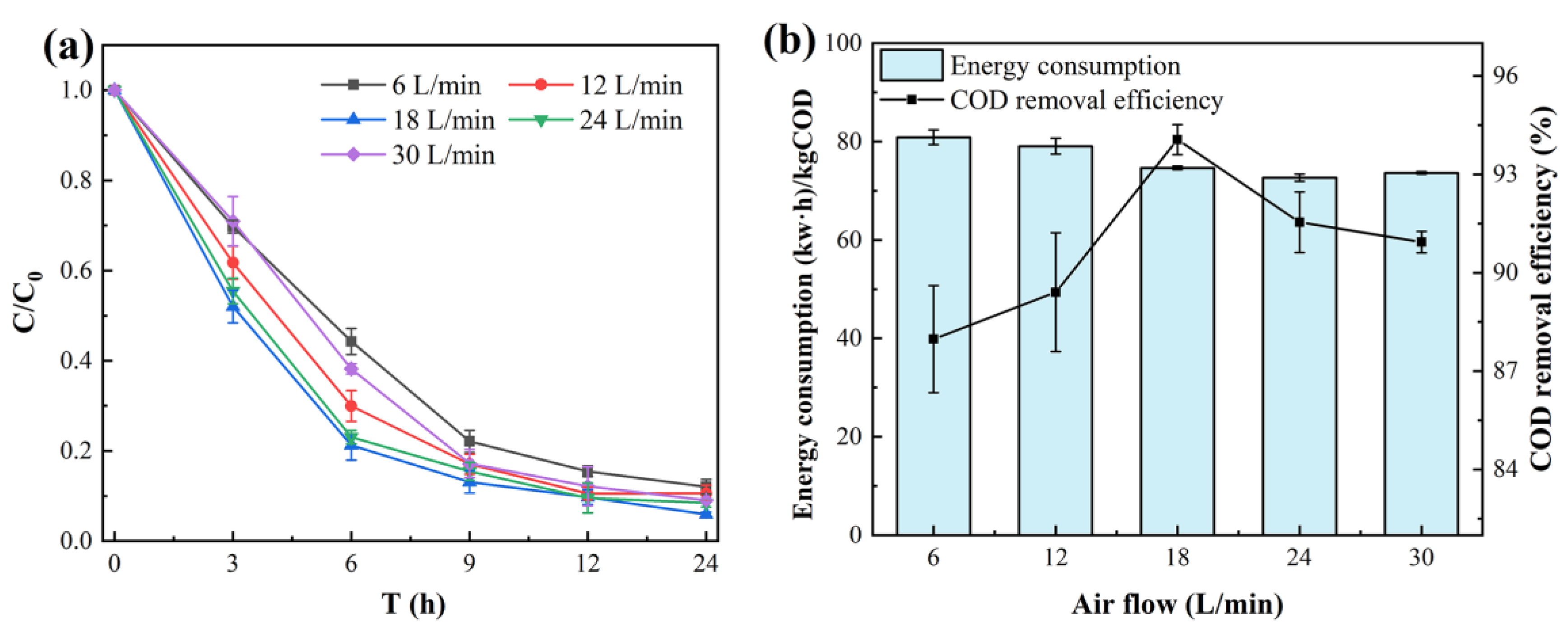

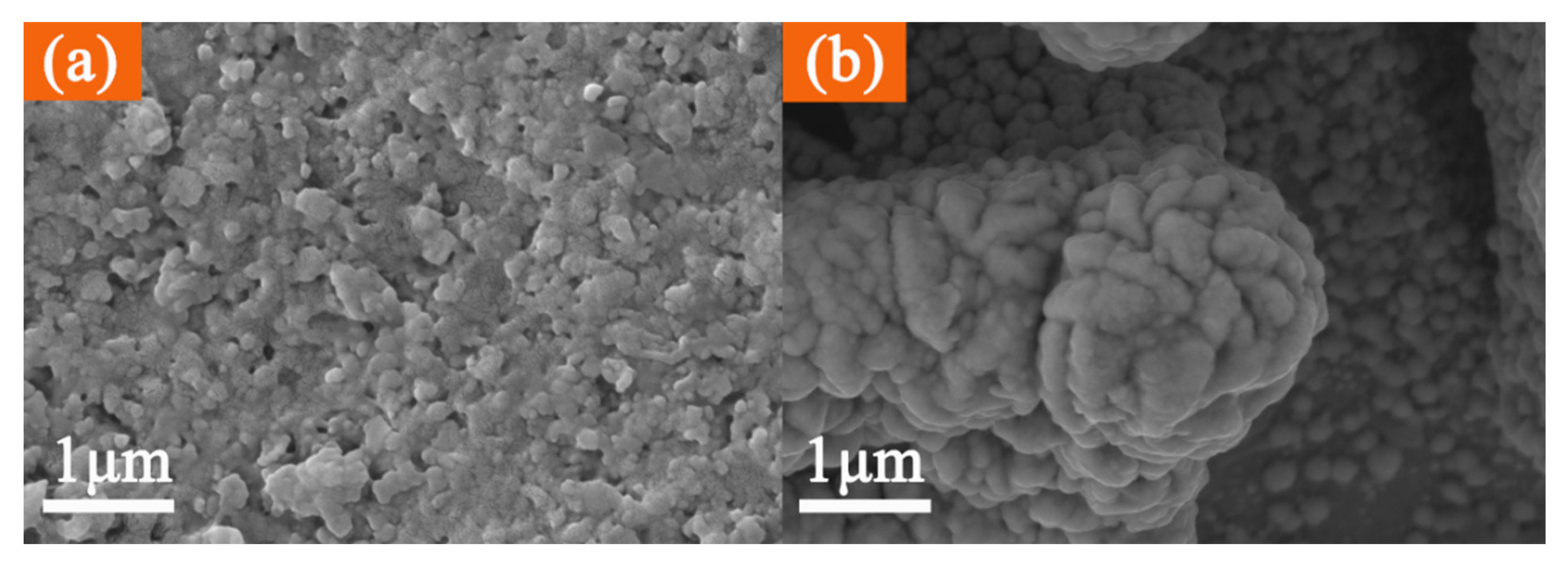
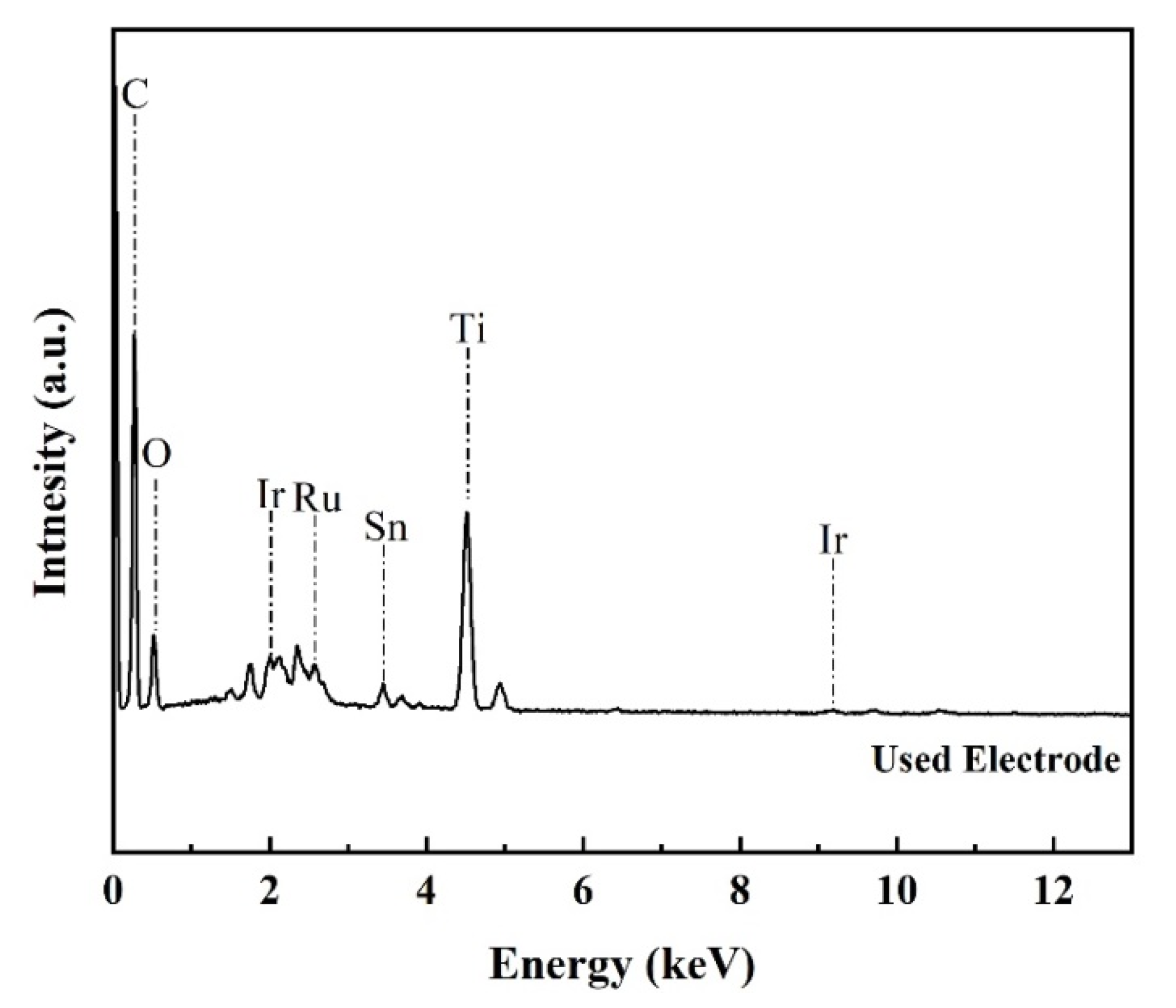
| Compound | Molecular Formula | Concentration | Unit | |
|---|---|---|---|---|
| 1 | Tetrahydrofuran | C4H8O | 303.438 | mg/L |
| 2 | ethyl acetate | C4H8O2 | 4179.921 | mg/L |
| 3 | ethanol | C2H6O | 18,016.768 | mg/L |
| Element | C | O | Ti | Ru | Ir | Sn |
|---|---|---|---|---|---|---|
| wt% | 9.86 | 42.03 | 27.37 | 8.71 | 4.56 | 7.47 |
| Element | C | O | Ti | Ru | Ir | Sn |
|---|---|---|---|---|---|---|
| wt% | 54.85 | 22.65 | 15.52 | 1.63 | 2.75 | 2.60 |
Publisher’s Note: MDPI stays neutral with regard to jurisdictional claims in published maps and institutional affiliations. |
© 2020 by the authors. Licensee MDPI, Basel, Switzerland. This article is an open access article distributed under the terms and conditions of the Creative Commons Attribution (CC BY) license (http://creativecommons.org/licenses/by/4.0/).
Share and Cite
Zhang, G.; Huang, X.; Ma, J.; Wu, F.; Zhou, T. Ti/RuO2-IrO2-SnO2 Anode for Electrochemical Degradation of Pollutants in Pharmaceutical Wastewater: Optimization and Degradation Performances. Sustainability 2021, 13, 126. https://doi.org/10.3390/su13010126
Zhang G, Huang X, Ma J, Wu F, Zhou T. Ti/RuO2-IrO2-SnO2 Anode for Electrochemical Degradation of Pollutants in Pharmaceutical Wastewater: Optimization and Degradation Performances. Sustainability. 2021; 13(1):126. https://doi.org/10.3390/su13010126
Chicago/Turabian StyleZhang, Guozhen, Xingxing Huang, Jinye Ma, Fuping Wu, and Tianhong Zhou. 2021. "Ti/RuO2-IrO2-SnO2 Anode for Electrochemical Degradation of Pollutants in Pharmaceutical Wastewater: Optimization and Degradation Performances" Sustainability 13, no. 1: 126. https://doi.org/10.3390/su13010126





